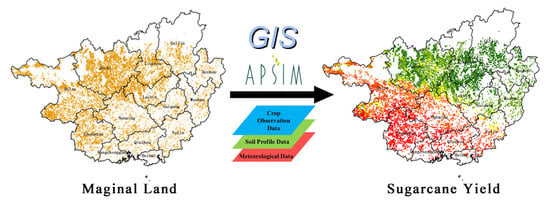Simulation of the Growth Potential of Sugarcane as an Energy Crop Based on the APSIM Model
Abstract
1. Introduction
2. Methods and Data
2.1. Study Sites
2.2. Methodology and Data Sources
2.2.1. Marginal Land Data
- (1)
- According to the principle of avoiding biofuel development that competes with people for food and that which competes with grain for land, as issued by the Ministry of Agriculture in 2007, arable land was excluded.
- (2)
- To protect the ecological environment and prevent the destruction of ecosystems, land types such as nature reserves, landscape, historical sites, and protected zones were excluded.
- (3)
- Taking into account the development needs for animal husbandry in China, the high- and medium-coverage grasslands of the five pasture areas in China were excluded.
- (4)
- According to the characteristics of land resources suitable for energy crop development, land use types such as swamp land, water bodies, and construction land were excluded. Land use types suitable for the cultivation of energy crops include shrub forest land, sparse forest land, grassland, mudflats, saline-alkali land, and bare land.
- (5)
- Based on the relevant literature [23], the growth characteristics of sugarcane were analyzed (see Table 1) and an index system of the natural conditions for sugarcane growth was established. Setting the lower limit of sugarcane requirements for soil, temperature, moisture, slope, and other conditions, the GIS technology was used to extract the land resources that were suitable for sugarcane planting.
2.2.2. Field Observation Data
2.2.3. Meteorological Data
2.2.4. Soil Profile Data
2.3. APSIM Module
2.3.1. APSIM and Sugarcane Module
2.3.2. Model Localization Settings
Meteorological Data
Soil Data
Crop Variety Data
2.4. Simulation of Sugarcane Production Process
2.5. Global Sensitivity Analysis Method
2.6. Sensitivity Analysis
- (1)
- In the statistical preprocessing module of SIMLAB software, input the range and distribution of eight crop variety parameters, use Monte Carlo method to sample all parameters 3000 times, and get the parameter sample set;
- (2)
- Python is used to input the generated parameter sample set into the configuration file of APSIM sugarcane model, then run APSIM model from the command line, and 3000 model output results are obtained;
- (3)
- The output of the previous step is input to the model processing module of SIMLAB, and the sensitivity analysis results of each parameter are calculated by EFAST method.
3. Results and Analysis
3.1. Sensitivity Analysis
3.2. Model Parameter Calibration
3.3. Model Validation
3.4. Model Simulation
3.5. Fuel Ethanol Production Potential
4. Discussion
5. Conclusions
Author Contributions
Funding
Acknowledgments
Conflicts of Interest
References
- Tian, C. Analysis of China’s Oil and Gas Import and Export in 2013. China Oil Gas 2014, 21, 36–41. [Google Scholar]
- Liu, Q.; Gu, A.; Teng, F.; Song, R.; Chen, Y. Peaking China’s CO2 Emissions: Trends to 2030 and Mitigation Potential. Energies 2017, 10, 209. [Google Scholar] [CrossRef]
- Chen, W.-H.; Lee, K.T.; Ong, H.C. Biofuel and Bioenergy Technology. Energies 2019, 12, 290. [Google Scholar] [CrossRef]
- Han, Y.; Kagawa, S.; Nagashima, F.; Nansai, K. Sources of China’s Fossil Energy-Use Change. Energies 2019, 12, 699. [Google Scholar] [CrossRef]
- National Energy Administration. Implementation Plan on Expanding Biofuel Ethanol Production and Promoting the Use of Automobile Ethanol Gasoline; National Energy Administration: Beijing, China, 2017.
- National Development and Reform Commission. “Eleventh Five-Year Plan” Development Special Plan for Biofuel Ethanol and Automobile Ethanol Gasoline; National Development and Reform Commission: Beijing, China, 2007.
- Ministry of Commerce. China-ASEAN Comprehensive Economic Cooperation Framework Agreement; Ministry of Commerce: Beijing, China, 2002.
- Li, Y.; Hou, H.; Wang, X.; Kuang, Z. Research Status and Prospect of Energy Plant. J. Anhui Agric. 2013, 41, 1682–1683. [Google Scholar]
- Shi, S.; Cheng, D.; Ma, F. Exploitation and Utilization of Biomass Energy Crop-Energy Beet. Chin. Agric. Sci. Bull. 2007, 23, 416–419. [Google Scholar]
- Xie, L.; Li, P.; Zhang, W.; Yang, M. A review on the development potential of bioenergy rapeseed. Chin. J. Bioprocess Eng. 2005, 1, 32–35. [Google Scholar]
- Cervi, W.R.; Camargo Lamparelli, R.A.; Abel Seabra, J.E.; Junginger, M.; van der Hilst, F. Bioelectricity potential from ecologically available sugarcane straw in Brazil: A spatially explicit assessment. Biomass Bioenergy 2019, 122, 391–399. [Google Scholar] [CrossRef]
- Singels, A.; Jarmain, C.; Bastidas-Obando, E.; Olivier, F.C.; Paraskevopoulos, A.L. Monitoring water use efficiency of irrigated sugarcane production in Mpumalanga, South Africa, using SEBAL. Water SA 2018, 44, 636–646. [Google Scholar] [CrossRef]
- Yawson, D.O.; Adu, M.O.; Osei, K.N. Spatial assessment of sugarcane (Saccharurn spp. L.) production to feed the Komenda Sugar Factory, Ghana. Heliyon 2018, 4, e00903. [Google Scholar] [CrossRef]
- Lisboa, I.P.; Damian, J.M.; Cherubin, M.R.; Silva Barros, P.P.; Fiorio, P.R.; Cerri, C.C.; Pellegrino Cerri, C.E. Prediction of Sugarcane Yield Based on NDVI and Concentration of Leaf-Tissue Nutrients in Fields Managed with Straw Removal. Agronomy 2018, 8, 196. [Google Scholar] [CrossRef]
- Satiro, L.S.; Cherubin, M.R.; Lisboa, I.P.; Noia Junior, R.S.; Cerri, C.C.; Pellegrino Cerri, C.E. Prediction of Sugarcane Yield by Soil Attributes under Straw Removal Management. Agron. J. 2019, 111, 14–23. [Google Scholar] [CrossRef]
- Dias, H.B.; Sentelhas, P.C. Sugarcane yield gap analysis in Brazil-A multi-model approach for determining magnitudes and causes. Sci. Total Environ. 2018, 637, 1127–1136. [Google Scholar] [CrossRef] [PubMed]
- Rodriguez, R.G.; Scanlon, B.R.; King, C.W.; Scarpare, F.V.; Xavier, A.C.; Pruski, F.F. Biofuel-water-land nexus in the last agricultural frontier region of the Brazilian Cerrado. Appl. Energy 2018, 231, 1330–1345. [Google Scholar] [CrossRef]
- Sanches, G.M.; Nonato de Paula, M.T.; Graziano Magalhaes, P.S.; Duft, D.G.; Vitti, A.C.; Kolln, O.T.; Montes Nogueira Borges, B.M.; Junqueira Franco, H.C. Precision production environments for sugarcane fields. Sci. Agric. 2019, 76, 10–17. [Google Scholar] [CrossRef]
- Guangxi Zhuang Autonomous Region Statistics Bureau. Guangxi Statistical Yearbook; Guangxi Zhuang Autonomous Region Statistics Bureau: Beijing, China, 2019.
- Huang, X.; Zhou, H.; Huang, M.; Zhao, J. Climate and temperature changes in Guangxi in the past 50 years. Guangxi Meteorol. 2005, 26, 9–11. [Google Scholar]
- Ministry of Agriculture and Rural Affairs. Opinions of the Ministry of Agriculture on Strengthening Energy Conservation and Emission Reduction in Agriculture and Rural Areas; Ministry of Agriculture and Rural Affairs: Beijing, China, 2007.
- Fu, J.; Jiang, D.; Hao, M. Research on the Development Potential of Non-Grain Fuel Ethanol in China; China Meteorological Press: Beijing, China, 2017.
- Li, R.; Zhang, Y.; Yang, D.; Qu, Y.; Guo, J. Study on development potential of full mechanization in diversity terrain of Yunnan sugarcane region. Chin. Agric. Mech. 2012, 4, 71–74. [Google Scholar]
- Ruan, H. Simulation Study on the Impact of Climate Change on Sugarcane Production Potential in Guangxi. Ph.D. Thesis, Guangxi University, Guangxi, China, 2018. [Google Scholar]
- He, H.; Luo, C.; Tang, L.; Ma, W.; Chen, H.; Wei, H.; Huang, Z. High-yield Cultivation Techniques of Guitang 32 in Chongzuo Cane Area. Chin. Trop. Agric. 2016, 3, 69–71. [Google Scholar]
- Zu, Q.; Mi, C.; Liu, D.L.; He, L.; Kuang, Z.; Fang, Q.; Ramp, D.; Li, L.; Wang, B.; Chen, Y.; et al. Spatio-temporal distribution of sugarcane potential yields and yield gaps in Southern China. Eur. J. Agron. 2018, 92, 72–83. [Google Scholar] [CrossRef]
- Xu, T.; Hutchinson, M.F. New developments and applications in the ANUCLIM spatial climatic and bioclimatic modelling package. Environ. Model. Softw. 2013, 40, 267–279. [Google Scholar] [CrossRef]
- Dai, Y.; Wei, S.; Duan, Q.; Liu, B.; Niu, G. Development of a China Dataset of Soil Hydraulic Parameters Using Pedotransfer Functions for Land Surface Modeling. J. Hydrometeorol. 2013, 14, 869–887. [Google Scholar] [CrossRef]
- Zuur, A.F.; Ieno, E.N.; Meesters, E.H.W.G. A Beginner’s Guide to R; Springer: New York, NY, USA, 2009. [Google Scholar]
- Saltelli, A.; Ratto, M.; Tarantola, S.; Campolongo, F. Sensitivity analysis practices: Strategies for model-based inference. Reliab. Eng. Syst. Saf. 2006, 91, 1109–1125. [Google Scholar] [CrossRef]
- Mao, J.; Inman-Bamber, N.G.; Yang, K.; Lu, X.; Liu, J.; Jackson, P.A.; Fan, Y. Modular Design and Application of Agricultural System Simulating Model for Sugarcane (APSIM-Sugar). Sugar Crop. China 2017, 39, 44–50. [Google Scholar]
- Tarantola, S.; Becker, W. Simlab 4.0 for Global Sensitivity Analysis. In Handbook of Uncertainty Quantification; Springer: New York, NY, USA, 2016; pp. 1–21. [Google Scholar]
- Willmott, J.C. Some Comments on the Evaluation of Model Performance. Bull. Am. Meteorol. Soc. 1982, 63, 1309–1313. [Google Scholar] [CrossRef]
- Su, Y.; Li, Z.; Sun, H. Climate Division of Sugarcane Planting Based on GIS in Guangxi. Chin. J. Agrometeorol. 2006, 27, 252–255. [Google Scholar]
- Li, Q.; Qi, R.; Zhang, Y. Development prospects of energy sugarcane to produce fuel ethanol. Sugarcane Canesugar 2004, 5, 29–33. [Google Scholar]
- Zeng, L.; An, Y.; Li, Q. Technical, Economic and Environmental Analysis of Fuel Ethanol Production from Sugarcane in China. Sugarcane Canesugar 2006, 2, 15–19. [Google Scholar]
- Li, Y.; Tan, Y.; Li, S.; Yang, R. Analyses on the potential of sugarcane as a bioenergy crop in China. Southwest China J. Agric. Sci. 2006, 19, 742–746. [Google Scholar]
- Xie, G. Progress and direction of non-food biomass feedstock supply research and development in China. J. China Agric. Univ. 2012, 17, 1–19. [Google Scholar]
- Zhang, J. Land potential analysis of biomass energy development in Guangxi. Mark. Forum 2008, 2, 9–14. [Google Scholar]
- Xu, Y.; Zhang, W. The Application on the Sugar Cane Forecast with the Neural Networks Using Improved Genetic Algorithms. J. South China Agric. Univ. 2010, 31, 102–104. [Google Scholar]
- Mao, J.; Wang, J.; Huang, M.; Lu, X.; Dao, J.; Zhang, Y.; Tao, L.; Yu, H. Effects of sowing date, water and nitrogen coupling management on cane yield and sugar content in sugarcane region of Yunan. Trans. Chin. Soc. Agric. Eng. 2019, 35, 134–144. [Google Scholar]
- Peng, Q.; Feng, L.; Deng, J.; Fan, X.; Zhang, Y. Application of BP Neural Network in Predication of Sugarcane Yield in Yunnan Province. Sugar Crop. China 2019, 41, 54–57. [Google Scholar]

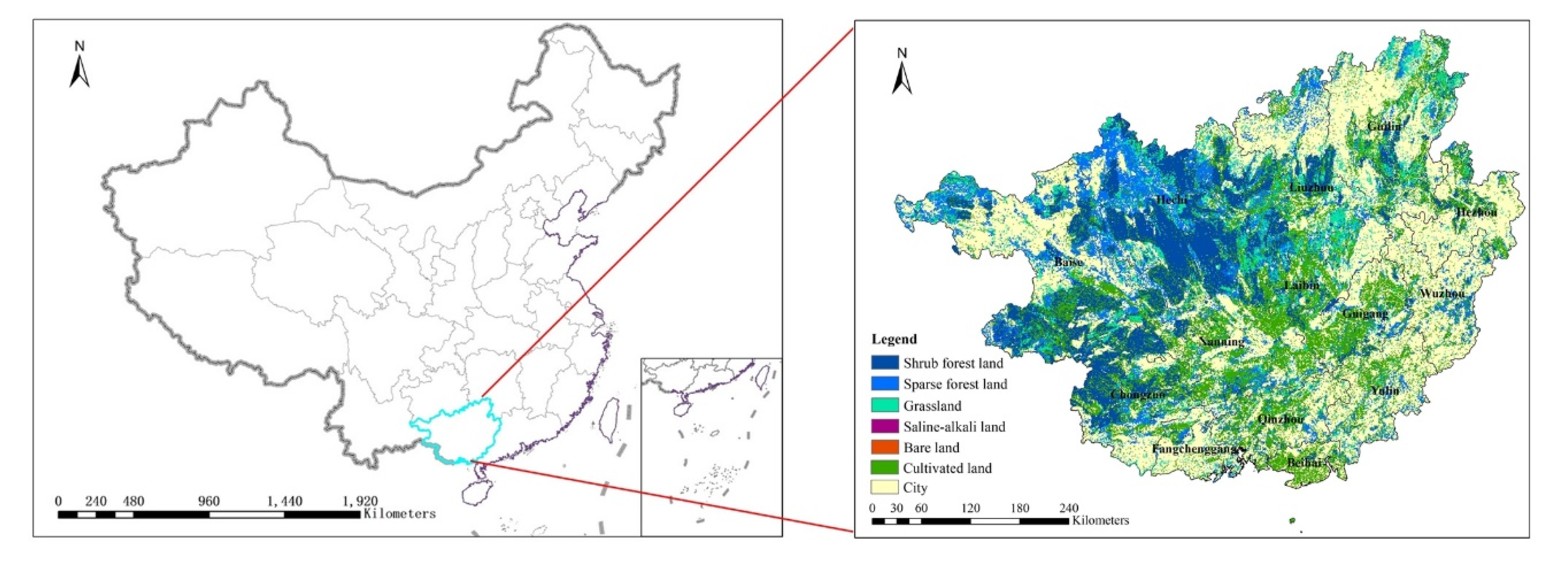
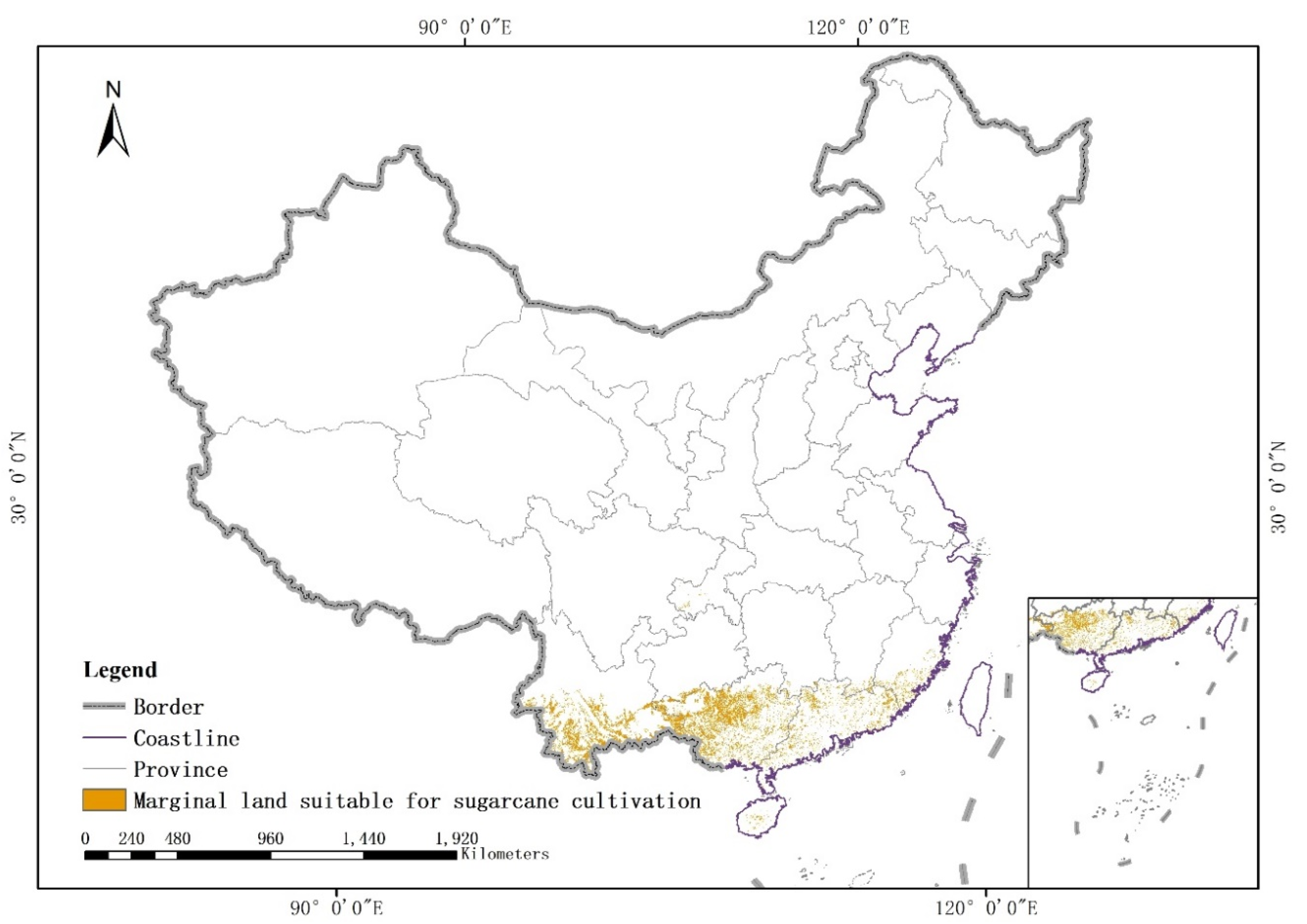
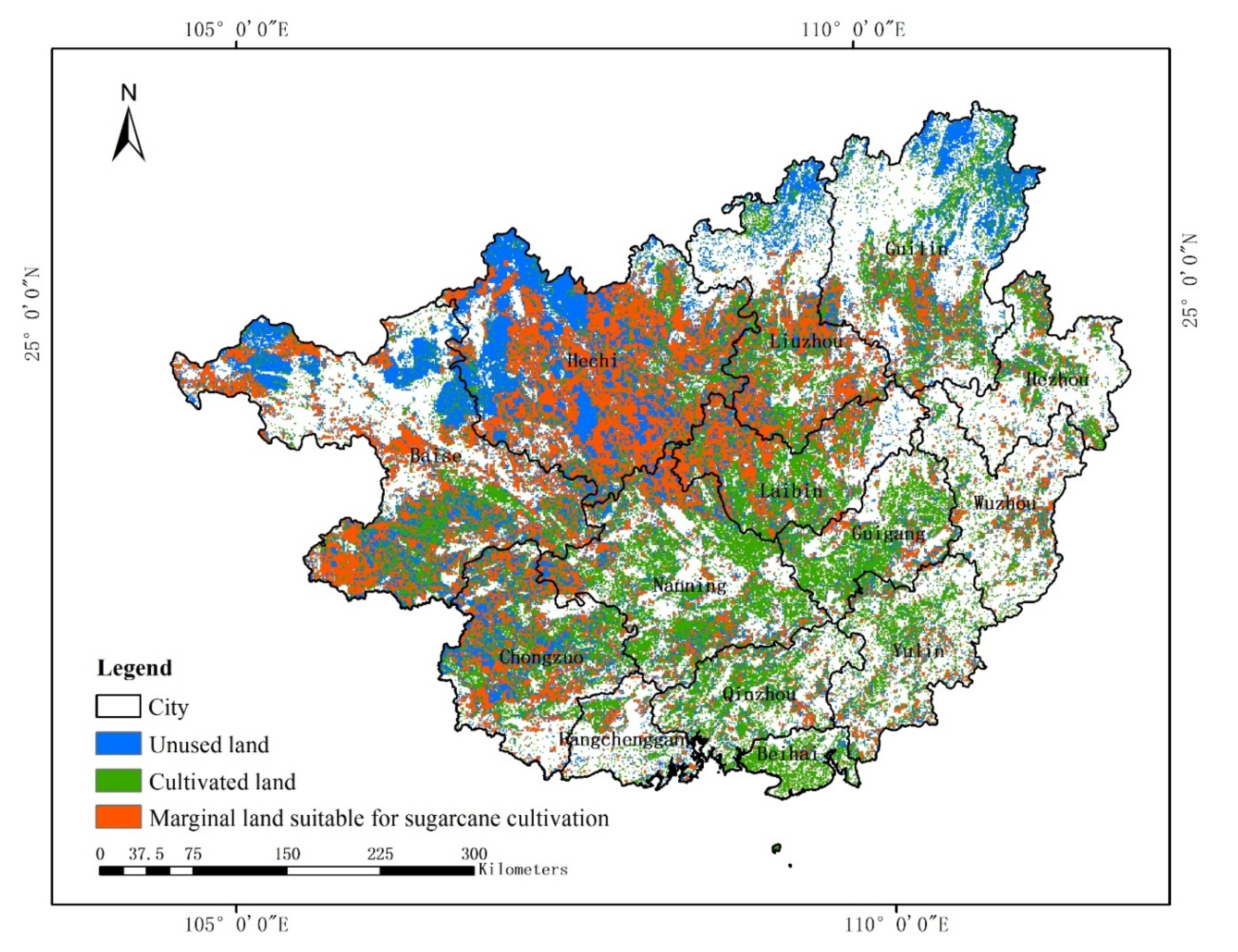
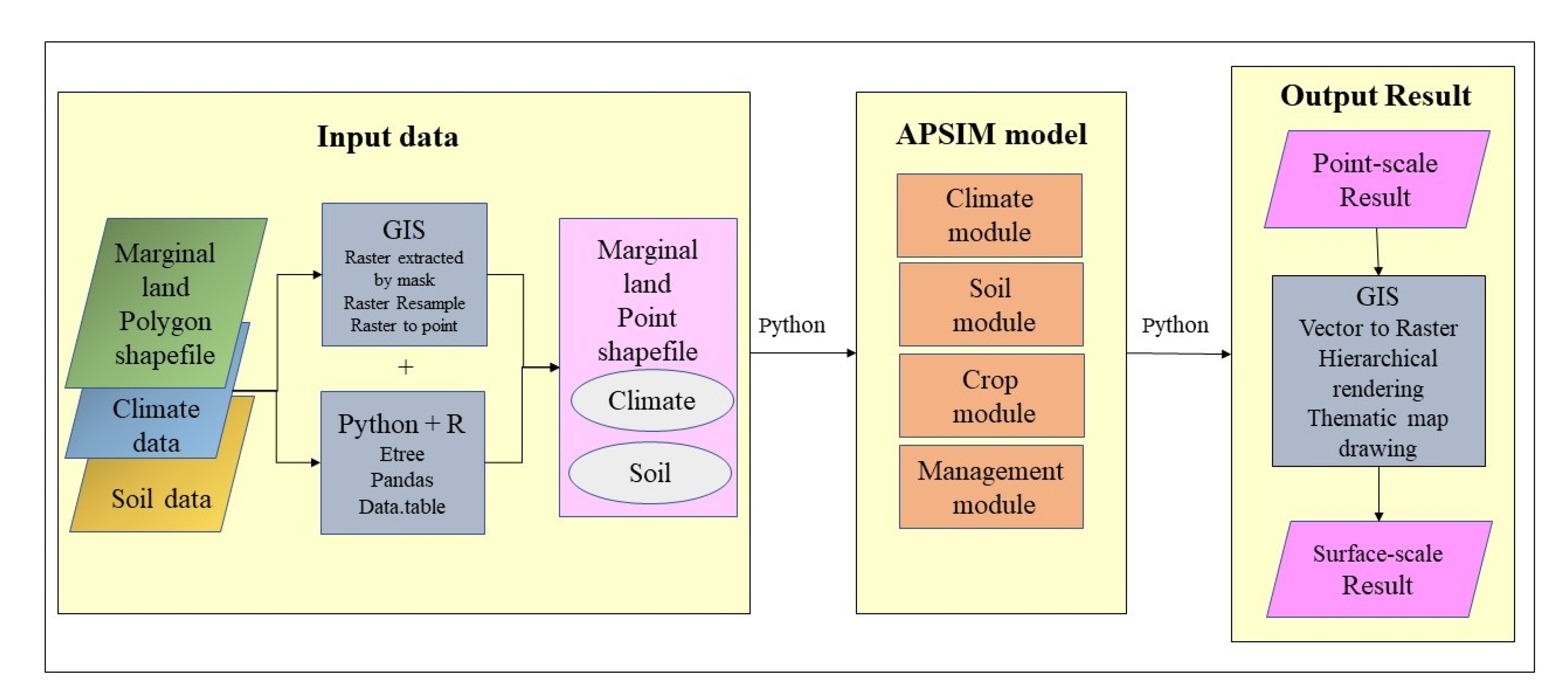

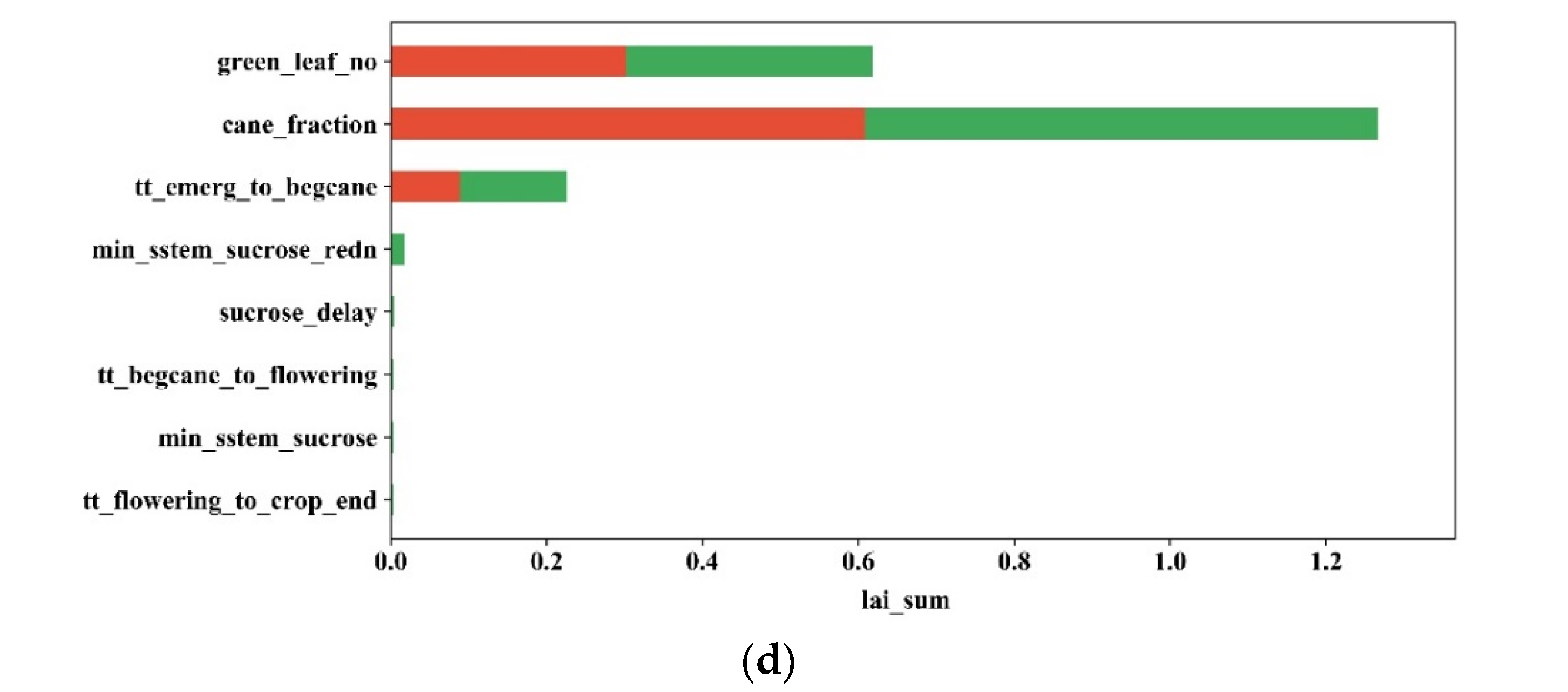
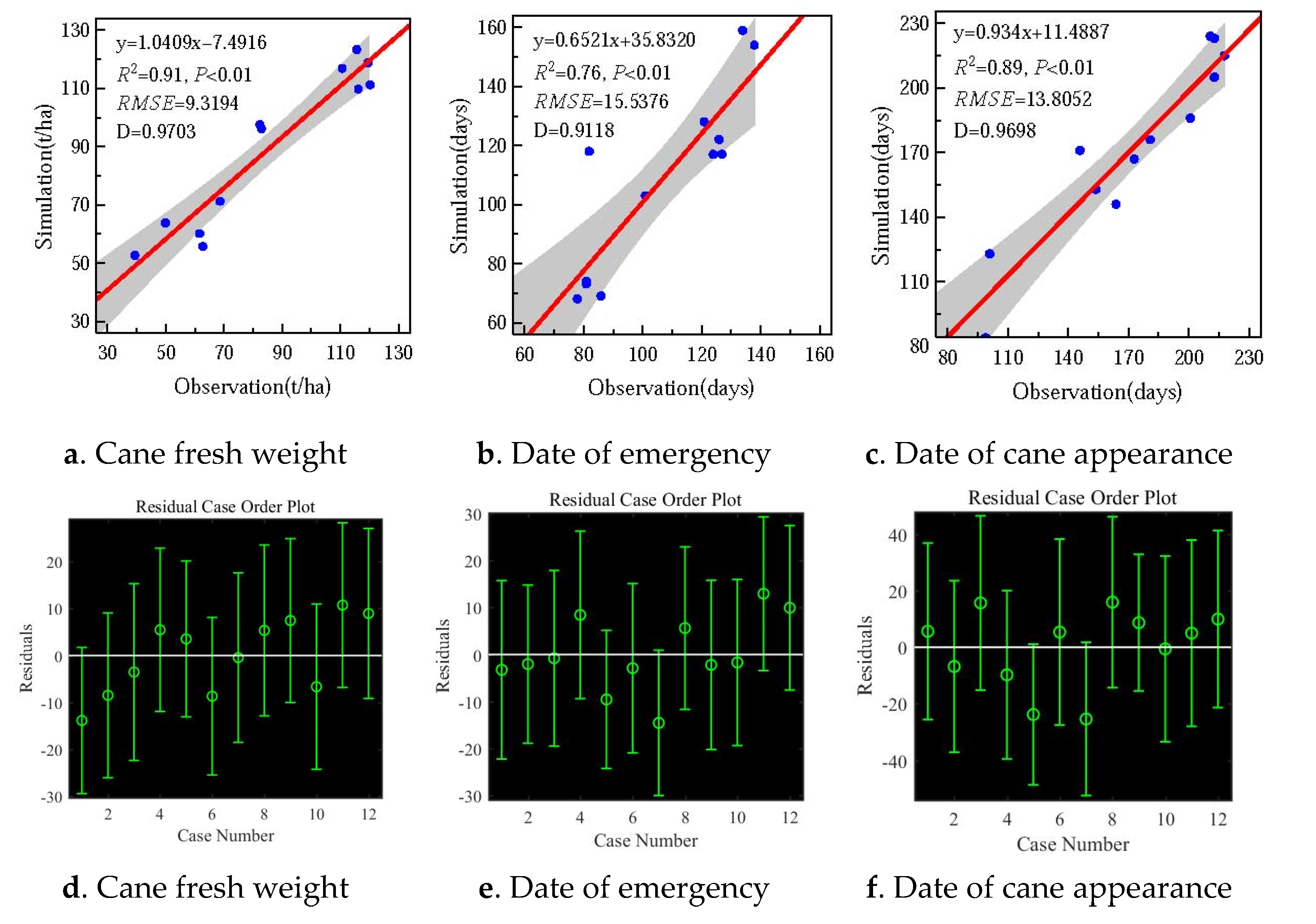

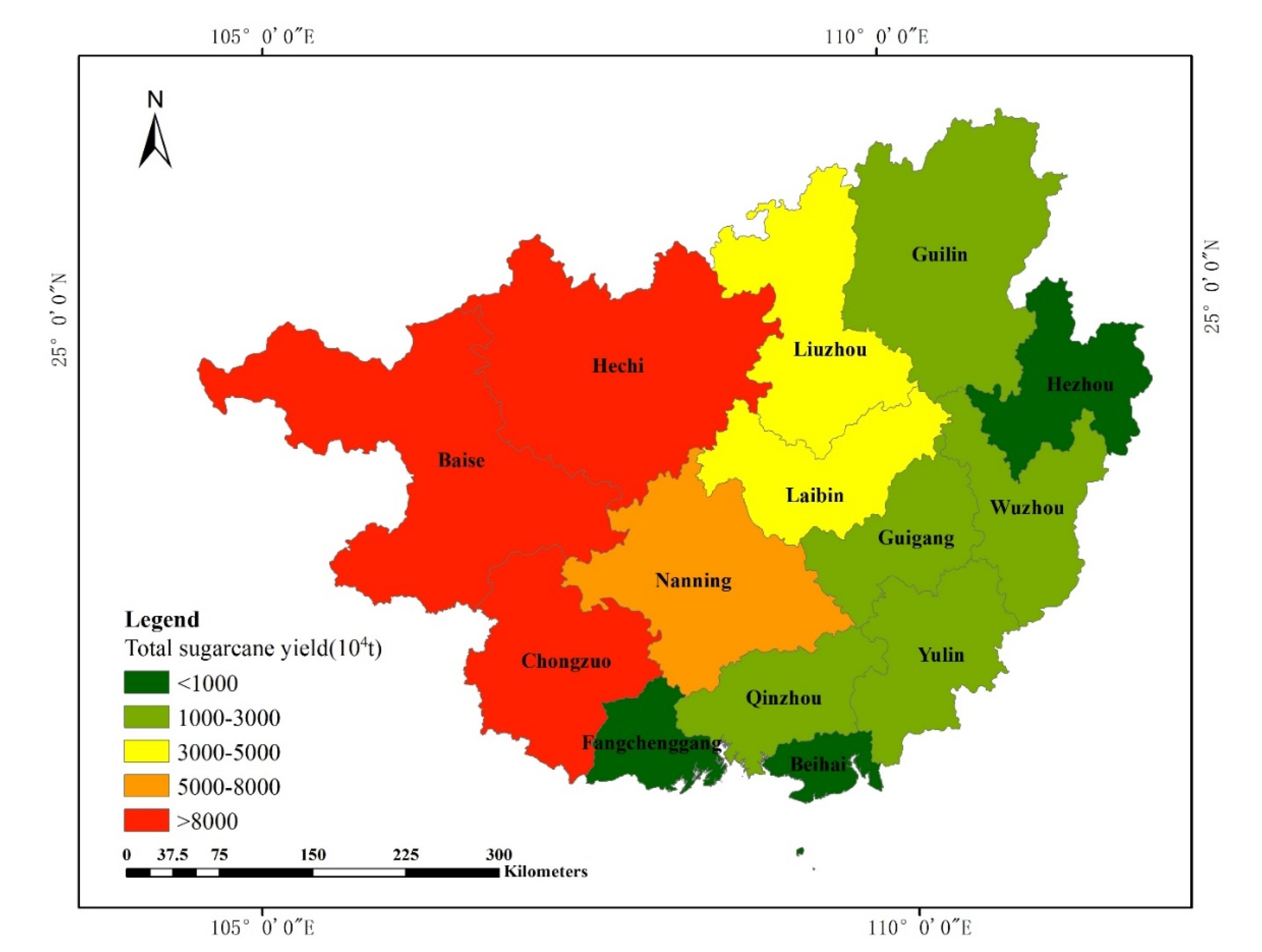
| Factor | Unit | Suitable Conditions | |
|---|---|---|---|
| Slope | <25 | ||
| Soil organic matter content | % | ≥2 | |
| Soil type | - | Loam or sandy loam | |
| pH | - | ≈4.5–8.0 | |
| Duration of sunshine | h | ≥1195 | |
| Cumulative temperature in base 10 °C | °C | ≈6500–8000 | |
| Jointing stage to maturity | - | ≈18–25 | |
| Average annual air humidity | % | Approximately 60% | |
| Annual precipitation | mm | ≈800–1200 | |
| Temperature | Germination | °C | ≥13 |
| Germination to seedling | °C | ≈20–25 | |
| Seedling stage to leaf stage | °C | ≈20–30 | |
| Leaf stage to jointing stage | °C | ≈25–28 | |
| Plant Type | Sowing Date | Emergence Date | Cane Appearance Date | Harvest Date | Leaf Area Index | Dry Weight (t·ha−1) | Cane Stem Yield (t·ha−1) | Sugar Dry Weight (t·ha−1) |
|---|---|---|---|---|---|---|---|---|
| Plant | 2015-02-03 | 2015-04-27 | 2015-07-24 | 2015-12-28 | 6.15 | 50.43 | 119.65 | 10.32 |
| Ratoon | 2015-12-28 | 2016-02-22 | 2016-06-29 | 2017-01-06 | 5.45 | 45.75 | 118.53 | 9.24 |
| Plant | 2015-03-15 | 2015-05-23 | 2015-08-08 | 2016-01-17 | 5.96 | 42.84 | 110.76 | 8.98 |
| Plant | 2015-04-16 | 2015-06-27 | 2015-07-08 | 2016-02-22 | 4.77 | 49.56 | 115.77 | 9.11 |
| Plant | 2016-02-28 | 2016-05-06 | 2016-07-30 | 2017-01-06 | 5.24 | 52.18 | 116.34 | 10.03 |
| Site | Plant Year | Plant Type | Sugarcane Stalk Yield (t·ha−1) | Phenological Period | ||||
|---|---|---|---|---|---|---|---|---|
| Sowing Date | Emergence Date | Cane Appearance Date | Harvest Date | |||||
| Calibration | Nanning | 2015 | Plant | 119.65 | 2015-02-03 | 2015-04-26 | 2015-07-24 | 2015-12-28 |
| Nanning | 2015/2016 | Ratoon | 118.53 | 2015-12-29 | 2016-02-22 | 2016-06-29 | 2017-01-06 | |
| Laibin | 2009/2010 | Ratoon | 62.83 | 2009-11-11 | 2010-03-03 | 2010-06-14 | 2010-11-10 | |
| Shatang | 2010 | Ratoon | 77.23 | 2010-02-26 | 2010-05-10 | 2010-07-20 | 2010-12-20 | |
| Guigang | 2010/2011 | Ratoon | 66.21 | 2010-11-21 | 2011-04-14 | 2011-06-30 | 2011-11-30 | |
| Yizhou | 2011/2012 | Ratoon | 54.43 | 2011-12-03 | 2012-04-16 | 2012-06-06 | 2012-11-10 | |
| Pingguo | 2011/2012 | Ratoon | 68.77 | 2011-12-11 | 2012-03-28 | 2012-06-14 | 2012-11-10 | |
| Validation | Laibin | 2010/2011 | Ratoon | 61.76 | 2010-11-11 | 2011-04-18 | 2011-06-22 | 2011-11-10 |
| Laibin | 2011/2012 | Ratoon | 67.71 | 2011-11-11 | 2012-04-10 | 2012-06-06 | 2012-11-07 | |
| Pingguo | 2009/2010 | Ratoon | 49.97 | 2009-11-11 | 2010-03-17 | 2010-06-23 | 2010-11-20 | |
| Pingguo | 2011 | Plant | 39.47 | 2011-02-27 | 2011-04-17 | 2011-06-30 | 2011-12-10 | |
| Shatang | 2011/2012 | Ratoon | 82.50 | 2011-12-21 | 2012-04-16 | 2012-06-14 | 2012-11-20 | |
| Shatang | 2012/2013 | Ratoon | 83.00 | 2012-11-21 | 2013-03-18 | 2013-06-14 | 2013-11-20 | |
| Guigang | 2009/2010 | Ratoon | 62.79 | 2009-11-20 | 2010-04-03 | 2010-06-18 | 2010-11-20 | |
| Guigang | 2011/2012 | Ratoon | 71.74 | 2011-12-01 | 2012-03-30 | 2012-06-06 | 2012-11-20 | |
| Yizhou | 2009/2010 | Ratoon | 60.25 | 2009-10-21 | 2010-03-10 | 2010-06-20 | 2010-11-10 | |
| Yizhou | 2011 | Plant | 53.78 | 2011-02-23 | 2011-04-14 | 2011-07-02 | 2011-12-02 | |
| Nanning | 2015 | Plant | 110.76 | 2015-03-15 | 2015-05-23 | 2015-08-08 | 2016-01-17 | |
| Nanning | 2016 | Plant | 116.34 | 2016-02-28 | 2016-05-06 | 2016-07-30 | 2017-01-26 | |
| Name | Definition | Unit | Remarks |
|---|---|---|---|
| Site | - | - | |
| Latitude | - | Decimal | |
| Tav | Annual average temperature | °C | |
| Amp | Monthly average temperature annual amplitude | °C | |
| Year | - | - | |
| Day | - | - | |
| Radn | Solar radiation | (MJ·m−2) | Non-negative |
| Maxt | Maximum temperature | (°C) | |
| Mint | Minimum temperature | (°C) | |
| Rain | Rainfall | (mm) | Non-negative |
| Name | Description | Unit |
|---|---|---|
| Depth | Layer depth | cm |
| AirDry | Air-dried soil moisture content | cm3·cm−3 |
| BD | Bulk density | g·cm−3 |
| LL15 | Permanent wilting coefficient | cm3·cm−3 |
| DUL | Field capacity | cm3·cm−3 |
| SAT | Saturated water content | cm3·cm−3 |
| NO3 | Nitrate nitrogen content | ppm |
| NH4 | Ammonia nitrogen content | ppm |
| pH | Potential of hydrogen | - |
| OC | Organic carbon content | % |
| Depth (cm) | BD (g·cm−3) | AirDry (cm3·cm−3) | DUL (cm3·cm−3) | LL15 (cm3·cm−3) | SAT (cm3·cm−3) | OC (%) | pH | NH4+-N (ppm) | NO3−-N (ppm) |
|---|---|---|---|---|---|---|---|---|---|
| 0–10 | 1.51 | 0.08 | 0.32 | 0.11 | 0.36 | 1.57 | 5.56 | 75.16 | 87.59 |
| 10–20 | 1.52 | 0.08 | 0.31 | 0.11 | 0.35 | 2.28 | 5.65 | 122.0 | 62.45 |
| 20–30 | 1.54 | 0.09 | 0.30 | 0.12 | 0.34 | 2.75 | 6.33 | 59.65 | 86.03 |
| 30–45 | 1.63 | 0.10 | 0.28 | 0.13 | 0.31 | 2.88 | 5.81 | 72.16 | 97.77 |
| 45–60 | 1.59 | 0.10 | 0.28 | 0.15 | 0.32 | 2.12 | 5.78 | 103.64 | 45.92 |
| 60–90 | 1.55 | 0.14 | 0.28 | 0.15 | 0.32 | 1.66 | 5.71 | 128.37 | 55.99 |
| 90–130 | 1.55 | 0.14 | 0.27 | 0.15 | 0.31 | 1.46 | 6.01 | 132.43 | 44.87 |
| Name | Description | Unit | Default Value |
|---|---|---|---|
| cane_fraction | Percentage of daily biomass allocated to cane stems | % | 0.70 |
| sucrose_delay | Sugarcane sugar accumulation delay factor | g·m−2 | 600.0 |
| min_sstem_sucrose | Minimum cane stalk biomass before sugar accumulation begins | g·m−2 | 1500 |
| min_sstem_sucrose_redn | Minimum sugarcane stem accumulation reduced under stress | g·m−2 | 10 |
| tt_emerg_to_begcane | Accumulated temperature from emergence to jointing | °C·d | 1900 |
| tt_begcane_to_flowering | Accumulated temperature from jointing to flowering | °C·d | 6000 |
| tt_flowering_to_crop_end | Accumulated temperature from flowering to maturity | °C·d | 2000 |
| green_leaf_no | The maximum number of green leaves before plant maturation | - | 13.0 |
| Name | Unit | Lower Limit | Upper Limit | Distribution |
|---|---|---|---|---|
| cane_fraction | % | 0.1 | 0.99 | Uniform |
| sucrose_delay | g·m−2 | 300 | 900 | Uniform |
| min_sstem_sucrose | g·m−2 | 750 | 2250 | Uniform |
| min_sstem_sucrose_redn | g·m−2 | 5 | 15 | Uniform |
| tt_emerg_to_begcane | °C·d | 1000 | 3000 | Uniform |
| tt_begcane_to_flowering | °C·d | 3000 | 9000 | Uniform |
| tt_flowering_to_crop_end | °C·d | 1000 | 3000 | Uniform |
| green_leaf_no | - | 5 | 20 | Uniform |
| Name | Description | Unit | Remarks |
|---|---|---|---|
| cane_wt | Sugarcane stem dry weight | g·m−2 | 1 t·ha−1 = 100 g·m−2 |
| canefw | Sugarcane stem fresh weight | t·ha−1 | |
| sucrose_wt | Sucrose dry weight | g·m−2 | 1 t·ha−1 = 100 g·m−2 |
| lai_sum | Leaf area index | m2·m−2 |
| Name | New Planting a | Ratoon b |
|---|---|---|
| cane_fraction | 0.9 | 0.9 |
| sucrose_delay | 565.62 | 0 |
| min_sstem_sucrose | 1338.70 | 1500 |
| min_sstem_sucrose_redn | 15 | 10 |
| tt_emerg_to_begcane | 1700 | 1900 |
| tt_begcane_to_flowering | 5000 | 6000 |
| tt_flowering_to_crop_end | 1230.83 | 2000 |
| green_leaf_no | 90 | 90 |
| District | District Area (km2) | Marginal Land Area (km2) | Sugarcane Stem Fresh Weight Yield (104 t) | Sugarcane Yield of Cropland (104 t) | Ethanol from Marginal Land (104 t) | Ethanol from Cropland (104 t) | Total Ethanol (104 t) |
|---|---|---|---|---|---|---|---|
| Baise | 36,201 | 9188 | 9771.00 | 257.29 | 814.25 | 10.72 | 824.97 |
| Beihai | 3989 | 1984 | 142.08 | 236.14 | 11.84 | 9.84 | 21.68 |
| Chongzuo | 17,332 | 4616 | 5613.28 | 2558.86 | 467.77 | 106.62 | 574.39 |
| Fangchenggang | 6239 | 556 | 688.30 | 301.08 | 57.36 | 12.55 | 69.90 |
| Guigang | 10,602 | 1248 | 997.06 | 227.40 | 83.09 | 9.48 | 92.56 |
| Guilin | 27,667 | 2628 | 1412.89 | 29.06 | 117.74 | 1.21 | 118.95 |
| Hechi | 33,476 | 12,232 | 9104.59 | 296.07 | 758.72 | 12.34 | 771.05 |
| Hezhou | 11,753 | 4108 | 739.33 | 12.41 | 61.61 | 0.52 | 62.13 |
| Laibin | 13,382 | 3932 | 2853.74 | 1108.72 | 237.81 | 46.20 | 284.01 |
| Liuzhou | 18,597 | 4108 | 2537.78 | 618.33 | 211.48 | 25.76 | 237.25 |
| Nangling | 22,099 | 4368 | 4646.96 | 1163.60 | 387.25 | 48.48 | 435.73 |
| Qinzhou | 10,897 | 1280 | 1492.07 | 317.08 | 124.34 | 13.21 | 137.55 |
| Wuzhou | 12,572 | 1372 | 996.57 | 11.02 | 83.05 | 0.46 | 83.51 |
| Yulin | 12,824 | 1504 | 1526.38 | 155.69 | 127.20 | 6.49 | 133.69 |
| Total | 237,630 | 53,124 | 42,522.05 | 7292.76 | 3543.50 | 303.87 | 3847.37 |
© 2020 by the authors. Licensee MDPI, Basel, Switzerland. This article is an open access article distributed under the terms and conditions of the Creative Commons Attribution (CC BY) license (http://creativecommons.org/licenses/by/4.0/).
Share and Cite
Peng, T.; Fu, J.; Jiang, D.; Du, J. Simulation of the Growth Potential of Sugarcane as an Energy Crop Based on the APSIM Model. Energies 2020, 13, 2173. https://doi.org/10.3390/en13092173
Peng T, Fu J, Jiang D, Du J. Simulation of the Growth Potential of Sugarcane as an Energy Crop Based on the APSIM Model. Energies. 2020; 13(9):2173. https://doi.org/10.3390/en13092173
Chicago/Turabian StylePeng, Ting, Jingying Fu, Dong Jiang, and Jinshuang Du. 2020. "Simulation of the Growth Potential of Sugarcane as an Energy Crop Based on the APSIM Model" Energies 13, no. 9: 2173. https://doi.org/10.3390/en13092173
APA StylePeng, T., Fu, J., Jiang, D., & Du, J. (2020). Simulation of the Growth Potential of Sugarcane as an Energy Crop Based on the APSIM Model. Energies, 13(9), 2173. https://doi.org/10.3390/en13092173






